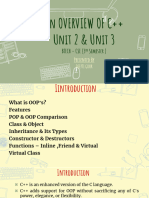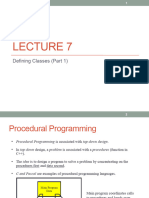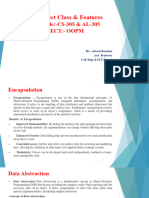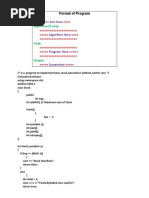SWE234 OOP Notes on class and object
Uploaded by
Eugene Mbah TeboSWE234 OOP Notes on class and object
Uploaded by
Eugene Mbah TeboSWE_234 PROGRAMMING II OOP.
NOTES 1 ON CLASS AND OBJECT
C++ Object Oriented Programming
Being an object-oriented programming language, C++ uses objects to model real-world problems
Unlike procedural programming, where functions are written to perform operations on data, OOP involves creating
objects that contain both data and functions.
An object has two characteristics: attributes and behavior. For example, a car can be an object. And, it has
• attributes - brand, model, size, mileage, etc.
• behavior - driving, acceleration, parking, etc.
C++ Class
A class is a blueprint for the object.
We can think of a class as the technical design (prototype) of a car. It contains all the details about the brand, model,
mileage, etc. We can then build different cars based on these descriptions. Here, each distinct car is an object.
An example for this can be:
A class named Car
class Car {
public:
// class data
string brand, model;
int mileage = 0;
// class function
void drive(int distance) {
mileage += distance;
}
};
In the above code, we have used the class keyword to create a class named Car. Here,
• brand and model are class attributes used to store data
• drive() is a class function used to perform some operation
The public keyword represents an access modifier..
C++ Objects
An object is an instance of a class.
For example, the Car class defines the model, brand, and mileage. Now, based on the definition, we can create objects
like
Car suv;
Car sedan;
Car van;
Here, suv, sedan, and van are objects of the Car class. Hence, the basic syntax for creating objects is:
Copyright @ Eugene Tebo December 2024
1
SWE_234 PROGRAMMING II OOP. NOTES 1 ON CLASS AND OBJECT
Class_Name object_name;
Example 1: Class and Objects in C++
#include <iostream>
using namespace std;
class Car {
public:
// class data
string brand, model;
int mileage = 0;
// class function to drive the car
void drive(int distance) {
mileage += distance;
}
// class function to print variables
void show_data() {
cout << "Brand: " << brand << endl;
cout << "Model: " << model << endl;
cout << "Distance driven: " << mileage << " miles" << endl;
}
};
int main() {
// create an object of Car class
Car my_car;
// initialize variables of my_car
my_car.brand = "Honda";
my_car.model = "Accord";
my_car.drive(50);
// display object variables
my_car.show_data();
return 0;
}
Output
Brand: Honda
Model: Accord
Distance driven: 50 miles
In this program, we have created a class Car with data members and a member function. Also, we have created an
object my_car of the Car class.
Notice that we have used the dot operator . with the my_car object in order to access the class members.
my_car.brand = "Honda";
my_car.model = "Accord";
Copyright @ Eugene Tebo December 2024
2
SWE_234 PROGRAMMING II OOP. NOTES 1 ON CLASS AND OBJECT
my_car.drive(50);
my_car.show_data();
Basic Principles of C++ Object-Oriented Programming
The foundational principles of C++ OOP are:
Bundling of related data and
Encapsulation functions together within a
single entity.
Showing only the essential
attributes of the class, while
Abstraction
hiding the technical details from
the user.
Using features from an existing
Inheritance class within a new class, without
modifying the existing class.
Ability of the same entity
Polymorphism (function or operator) to behave
differently in different scenarios.
Let's look at these principles in greater detail.
1. C++ Encapsulation
In C++, object-oriented programming allows us to bundle together data members (such as variables, arrays, etc.) and its
related functions into a single entity. This programming feature is known as encapsulation.
Encapsulation in C++
Copyright @ Eugene Tebo December 2024
3
SWE_234 PROGRAMMING II OOP. NOTES 1 ON CLASS AND OBJECT
In Example 1, we bundled together the related variables brand, model and mileage with the function show_data() into
a class named Car.
class Car {
public:
// class data
string brand;
string model;
int mileage = 0;
// class function
void show_data() {
// code
}
};
Encapsulation ensures that only member functions of a class can access its data, which results in data hiding.
In C++, we hide data using the private and protected keywords. In contrast, using the public keyword for certain class
members makes those members accessible to all other functions and classes.
2. C++ Abstraction
In object-oriented programming, abstraction refers to the concept of showing only the necessary information to the user
i.e. hiding the complex details of program implementation and execution.
For example, let us consider a slightly modified version of the Car class:
class Car {
private:
// class data
int speed;
// class function
void show_car_status() {
// code
}
};
Suppose we want the show_car_status() function to show the status of the car based on the value of the speed variable.
We can implement such conditional statements using the if...else statement inside the show_car_status() function.
void show_car_status() {
if (speed != 0)
cout << "The car is being driven." << endl;
else
cout << "The car is stationary." << endl;
}
Here, we do not need to show the user all the codes we have written to determine if the car is stationary or not; we just
need to show them whether the car is being driven or not depending on its speed.
In other words, we are only giving useful and relevant information to the user, while hiding all the unnecessary details.
This is data abstraction in OOP.
Copyright @ Eugene Tebo December 2024
4
SWE_234 PROGRAMMING II OOP. NOTES 1 ON CLASS AND OBJECT
Note: Abstraction is not the same as data hiding. Abstraction is showing only the relevant information, while data
hiding is restricting access to data members (variables, arrays, structures, etc.) so that they cannot be accessed from
outside the class.
3. C++ Inheritance
Inheritance in C++ allows us to create a new class (derived class) from an existing class (base class).
The derived class inherits features from the base class and can have additional features of its own.
Example 2: Use of Inheritance in C++
#include <iostream>
using namespace std;
// base class
class Vehicle {
public:
string brand;
void show_brand() {
cout << "Brand: " << brand << endl;
}
};
// derived class
class Car : public Vehicle {
public:
string model;
void show_model() {
cout << "Model: " << model << endl;
}
};
int main() {
// create an object of Car class
Car my_car;
// initialize variables of my_car
my_car.brand = "Honda";
my_car.model = "Accord";
// display variables of my_car
my_car.show_brand();
my_car.show_model();
return 0;
}
Output
Brand: Honda
Model: Accord
Copyright @ Eugene Tebo December 2024
5
SWE_234 PROGRAMMING II OOP. NOTES 1 ON CLASS AND OBJECT
Here,
• Vehicle is the base class.
• Car is the derived class.
The derived class inherits the features of the base class. We can see this from the brand variable and
the show_brand() function, since the Car object my_car can access them.
In addition to the features of the base class, the derived class also has features of its own. The unique features of
the Car class are:
• model - a string variable
• show_model() - a function that prints the model variable.
We can also see that the Vehicle class has not been modified by its derived class.
4. C++ Polymorphism
Polymorphism is the ability to use a common function (or operator) in multiple ways.
In C++, polymorphism is implemented with the help of function overloading, operator overloading, function overriding,
and virtual functions.
Let's look at function overriding as an example.
#include <iostream>
using namespace std;
// base class
class Shape {
public:
// function of base class
void shape_name() {
cout << "Shape" << endl;
}
};
// derived class
class Square : public Shape {
public:
// overriding function of derived class
void shape_name() {
cout << "Square" << endl;
}
};
int main() {
// create class objects
Shape shape;
Square square;
// call function from Shape class
shape.shape_name();
// call function from Square class
square.shape_name();
return 0;
}
Copyright @ Eugene Tebo December 2024
6
SWE_234 PROGRAMMING II OOP. NOTES 1 ON CLASS AND OBJECT
Output
Shape
Square
Here,
• Shape is the base class.
• Square is the derived class.
Both these classes have a function called shape_name(). But the body of the shape_name() function are different in the
two classes.
When the shape_name() function is called by the shape object, the code inside the function of the Shape class is
executed.
However, when shape_name() is called by the square object, the code inside the body of Square class is executed.
Thus, we have used the same function shape_name() in two different ways using C++ polymorphism.
Copyright @ Eugene Tebo December 2024
7
You might also like
- Object Oriented Programming CS Class XIINo ratings yetObject Oriented Programming CS Class XII6 pages
- Data Structures Through C++: Chapter - 1 1.1. C++ Class Overview-Basic Oop ConceptsNo ratings yetData Structures Through C++: Chapter - 1 1.1. C++ Class Overview-Basic Oop Concepts31 pages
- WINSEM2024-25_BCSE102L_TH_VL2024250501598_2025-02-18_Reference-Material-INo ratings yetWINSEM2024-25_BCSE102L_TH_VL2024250501598_2025-02-18_Reference-Material-I26 pages
- Classes and Objects: Definition of OOPSNo ratings yetClasses and Objects: Definition of OOPS10 pages
- Kendravidyale 12 - Basic - Concepts - of - Oop - Classes - and - ObjectssNo ratings yetKendravidyale 12 - Basic - Concepts - of - Oop - Classes - and - Objectss24 pages
- Ques: Explain Oops Concepts in Detail With ExampleNo ratings yetQues: Explain Oops Concepts in Detail With Example17 pages
- Lecture Notes ON: Cs1312 - Object Oriented ProgrammingNo ratings yetLecture Notes ON: Cs1312 - Object Oriented Programming79 pages
- OOP - Topic 07 - Lecture - Introduction To C++No ratings yetOOP - Topic 07 - Lecture - Introduction To C++67 pages
- C++ Oops Concepts Oops (Object Oriented Programming System)No ratings yetC++ Oops Concepts Oops (Object Oriented Programming System)17 pages
- Object Oriented Programming Using C++ (UNIT 1)No ratings yetObject Oriented Programming Using C++ (UNIT 1)54 pages
- IGNOU PGDCA MCS 206 Object Oriented Programming using Java Previous Years solved PapersFrom EverandIGNOU PGDCA MCS 206 Object Oriented Programming using Java Previous Years solved PapersNo ratings yet
- Python Advanced Programming: The Guide to Learn Python Programming. Reference with Exercises and Samples About Dynamical Programming, Multithreading, Multiprocessing, Debugging, Testing and MoreFrom EverandPython Advanced Programming: The Guide to Learn Python Programming. Reference with Exercises and Samples About Dynamical Programming, Multithreading, Multiprocessing, Debugging, Testing and MoreNo ratings yet
- CWD116 LectureNotes 2 Intro Web ProgramminNo ratings yetCWD116 LectureNotes 2 Intro Web Programmin13 pages
- ICT316_SWE316_Introduction to Programming LectNotes Nov2024No ratings yetICT316_SWE316_Introduction to Programming LectNotes Nov202419 pages
- Assignment 1 Csc404 (Syafiqah Batrisyia)No ratings yetAssignment 1 Csc404 (Syafiqah Batrisyia)11 pages
- The Simplest Protocol For Oblivious TransferNo ratings yetThe Simplest Protocol For Oblivious Transfer17 pages
- High Level Digital Design & Testing (HLDDT)No ratings yetHigh Level Digital Design & Testing (HLDDT)126 pages
- Activity Sheet 11 - Gr.11 - Exponential FunctionNo ratings yetActivity Sheet 11 - Gr.11 - Exponential Function2 pages
- MAT2002 - DISCRETE-MATHEMATICS-AND-GRAPH-THEORY - LT - 1.1 - 67 - MAT2002 - Discrete Mathematics and Graph Theory - LT - 4 - V1.1No ratings yetMAT2002 - DISCRETE-MATHEMATICS-AND-GRAPH-THEORY - LT - 1.1 - 67 - MAT2002 - Discrete Mathematics and Graph Theory - LT - 4 - V1.12 pages
- 8.2 TCHR NOTES Venn Diagrams and Sample SpacesNo ratings yet8.2 TCHR NOTES Venn Diagrams and Sample Spaces8 pages
- Unit 8.2 Its All in The Planning - Pseudocode and Algorithm Learning ObjectivesNo ratings yetUnit 8.2 Its All in The Planning - Pseudocode and Algorithm Learning Objectives4 pages
- Laboratory Workbook: Sinhgad Institute of Management & Computer Application (SIMCA)100% (2)Laboratory Workbook: Sinhgad Institute of Management & Computer Application (SIMCA)77 pages
- MurreyMathCalculator, Version 1.3 (Dec 1999)No ratings yetMurreyMathCalculator, Version 1.3 (Dec 1999)3 pages
- Data Structures Through C++: Chapter - 1 1.1. C++ Class Overview-Basic Oop ConceptsData Structures Through C++: Chapter - 1 1.1. C++ Class Overview-Basic Oop Concepts
- WINSEM2024-25_BCSE102L_TH_VL2024250501598_2025-02-18_Reference-Material-IWINSEM2024-25_BCSE102L_TH_VL2024250501598_2025-02-18_Reference-Material-I
- Kendravidyale 12 - Basic - Concepts - of - Oop - Classes - and - ObjectssKendravidyale 12 - Basic - Concepts - of - Oop - Classes - and - Objectss
- Ques: Explain Oops Concepts in Detail With ExampleQues: Explain Oops Concepts in Detail With Example
- Lecture Notes ON: Cs1312 - Object Oriented ProgrammingLecture Notes ON: Cs1312 - Object Oriented Programming
- C++ Oops Concepts Oops (Object Oriented Programming System)C++ Oops Concepts Oops (Object Oriented Programming System)
- IGNOU PGDCA MCS 206 Object Oriented Programming using Java Previous Years solved PapersFrom EverandIGNOU PGDCA MCS 206 Object Oriented Programming using Java Previous Years solved Papers
- Python Advanced Programming: The Guide to Learn Python Programming. Reference with Exercises and Samples About Dynamical Programming, Multithreading, Multiprocessing, Debugging, Testing and MoreFrom EverandPython Advanced Programming: The Guide to Learn Python Programming. Reference with Exercises and Samples About Dynamical Programming, Multithreading, Multiprocessing, Debugging, Testing and More
- ICT316_SWE316_Introduction to Programming LectNotes Nov2024ICT316_SWE316_Introduction to Programming LectNotes Nov2024
- MAT2002 - DISCRETE-MATHEMATICS-AND-GRAPH-THEORY - LT - 1.1 - 67 - MAT2002 - Discrete Mathematics and Graph Theory - LT - 4 - V1.1MAT2002 - DISCRETE-MATHEMATICS-AND-GRAPH-THEORY - LT - 1.1 - 67 - MAT2002 - Discrete Mathematics and Graph Theory - LT - 4 - V1.1
- Unit 8.2 Its All in The Planning - Pseudocode and Algorithm Learning ObjectivesUnit 8.2 Its All in The Planning - Pseudocode and Algorithm Learning Objectives
- Laboratory Workbook: Sinhgad Institute of Management & Computer Application (SIMCA)Laboratory Workbook: Sinhgad Institute of Management & Computer Application (SIMCA)





































































































